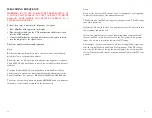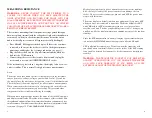
10
CHECKING TRANSISTORS
Follow these steps to determine a transistor's pinout, type, and base gain.
• Plug a transistor into the hFE socket.
• Press
hFE
. hFE appears in the display.
The meter displays the transistor type (NPN or PNP) for several seconds.
Then, the meter displays the transistor's pinout. The three letters it dis-
plays correspond to the three terminals of the hFE socket. For example,
if the meter displays EbC, the far left lead is the emitter, the middle
lead is the base, and the far right lead is the collector.
After a short pause, the meter displays the transistor's hFE. This value
ranges from 1 to 39.999.
The meter continuously displays the hFE. If you plug in another tran-
sistor, it displays that transistor's hFE, if it is of the same type and has
the same pinout. To force the meter to re-examine the transistor type
and pinout, press hFE after you install a new transistor.
Notes:
Do not take the hFE reading as an absolute measurement, but rather as
an indication that the transistor is operating. The true gain of a transis-
tor depends on its operating current. This meter applies 500 to 1000 A
to the emitter and collector and measures the base current to calculate
the base gain.
Even though the meter turns off the test leads during the hFE measure-
ment, a voltage connection might affect the hFE reading. Do not con-
nect the test leads to a voltage source during this measurement.
You cannot measure the hFE of a transistor that is connected in a circuit.
You cannot measure the hFE of a FET or other non-bipolar transistor.
Some power darlington transistors contain internal base-to-emitter re-
sistors. Because the meter uses two current readings to calculate hFE,
any internal transistor resistance causes undependable readings.
7
When you measure resistances greater than 400 K ohms, your skin's
resistance can affect the reading. Use the OHMS/DIODE/CAP socket
to measure loose resistors, if possible. If you must hold the resistor and
use the probes, do not touch both probes while you take a measurement.
Checking Continuity
Follow these steps to check a circuit's continuity:
• Press
/
CONT
so that [
CONT
] and appear in the display. The meter
sets itself to the 400-ohm resistance range.
• Connect the red test lead to the /
.
mA terminal and the black test
lead to the COM terminal.
• Connect the probes to the circuit you want to test.
If the circuit's resistance is less than or equal to 50 ohms, the buzzer
sounds. If the resistance is greater than 50 ohms, but less than 400
ohms, the meter displays the circuit's resistance and the buzzer does not
sound. The meter indicates an overrange condition if the resistance is
400 ohms or greater.
Note: The beep sounds even if you turn off the beep option. If the meter
performs a battery check while the continuity tone is sounding, the tone
stops for about 1/2 second.








